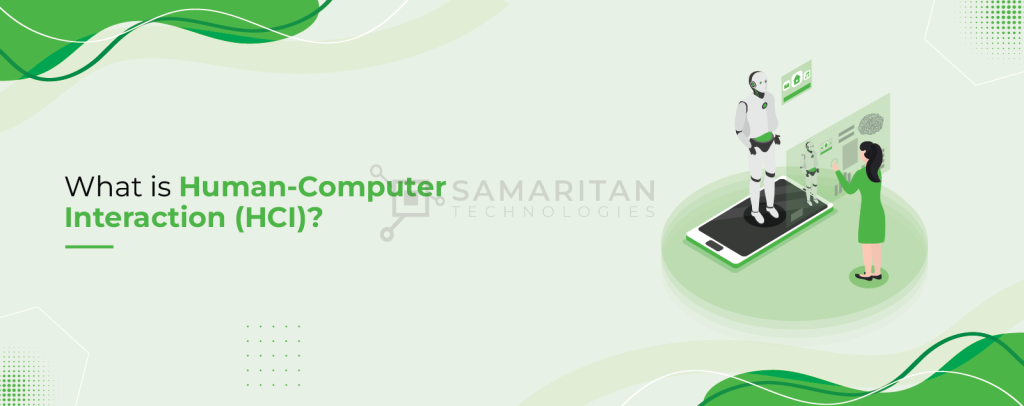AI has the potential to completely transform human-computer interaction and bring in a new age of smooth human-machine cooperation. Our interactions with computers become more instinctive and natural as AI capabilities develop. Voice recognition, gesture control, and user-preference-aware prediction algorithms are prime examples of this change.
AI’s capacity to perceive and react to human emotions improves interactivity even further. AI is changing how we interact with technology, from smart homes and intuitive user interfaces to individualized virtual assistants. This piece delves into the fascinating ways artificial intelligence (AI) has the potential to improve human-computer interaction and make technology more approachable and intuitive for everybody.

What is Human-Computer Interaction (HCI)?
The study of human-computer interaction (HCI) is concerned with the development and assessment of user-friendly and efficient computer technology.
HCI professionals employ a range of academic fields, such as design, psychology, sociology, and computer science, to develop user-centred interfaces that satisfy the requirements of businesses and individuals.
Important components of HCI:
User-centered design:
HCI places a strong emphasis on the value of comprehending users’ requirements, objectives, and habits at every stage of the design process. This entails gathering user data, constructing user personas, and building prototypes that are tested and improved upon repeatedly in response to user input.
Usability:
The goal of HCI is to make computer systems simple to use, comprehend, and acquire knowledge of. This involves creating user-friendly, dependable, and effective interface designs. In order to find and fix any usability problems, HCI practitioners also assess how user-friendly current systems are.
Accessibility:
Human-computer interaction (HCI) aims to design inclusive interfaces that persons with physical, sensory, or cognitive disabilities can utilize. In order to do this, features like keyboard navigation, alternate text, and screen readers must be included, along with accessibility requirements.
User experience (UX):
HCI includes the more general notion of user experience (UX), which includes the feelings and impressions a user has when using a product or service.

Which aspects of HCI will AI transform?
AI has the potential to revolutionize a number of , HCI facets, facilitating more organic, intuitive, and tailored user experiences:
Natural Language Processing (NLP) in Context of Intuitive Speech:
The use of natural language in computer interactions will be completely transformed by AI-powered NLP. Conversational AI technologies, such as virtual assistants and chatbots, will allow humans to communicate with computers in daily language, improving the naturalness and resemblance of interactions.
Computer Vision and Gesture Recognition for Smooth Interactions: Computers will be able to comprehend and react to non-verbal signs like hand gestures, body language, and facial emotions thanks to AI-powered computer vision and gesture recognition. More natural and immersive interactions will be possible as a result, especially in fields like augmented and virtual reality.
Machine Learning and Personalization for Tailored User Experiences: Computers will be able to customize user experiences according to unique tastes, actions, and circumstances thanks to AI-powered machine learning algorithms. Because computers can now adjust to the specific requirements and expectations of each user, interactions will become more relevant and engaging.
AI-Powered Design Tools for Developing Intuitive and Accessible Interfaces: AI will provide designers with smart tools to work with, enabling them to examine user data and derive ideas for designing interfaces that are easier to use and more accessible. These technologies can guarantee adherence to accessibility rules, provide recommendations for design enhancements, and spot usability problems.
AI-Powered Virtual Assistants and Chatbots for Better Customer Service:
AI-powered chatbots and virtual assistants will offer round-the-clock customer assistance, responding to inquiries, resolving problems, and helping customers with challenging tasks. Customers will be more satisfied as a result, and customer support agents will have less work to do.
AI-Powered Adaptive Learning Platforms:
AI will make education more individualized by developing learning environments that adapt to the abilities, learning preferences, and speed of each individual student. Meeting the requirements of each student individually and optimizing educational results, this will enhance the learning process.
AI-Powered Diagnostics and Tailored Treatment Plans in Healthcare:
AI will help medical practitioners by looking for trends in patient data and recommending individualized courses of action. Facilitating early diagnosis, individualized treatment strategies, and risk assessment, will enhance healthcare outcomes.
How will AI impact different industries and applications?

With AI, user experiences may become more customized, intuitive, and natural, which will completely transform HCI. Let’s explore how AI is transforming different industries and applications:
Healthcare: AI-powered medication discovery, virtual assistants, and medical imaging analysis
Education: AI-driven tutoring programs, adaptive learning platforms, and language translation instruments
Customer support: sentiment analysis, predictive analytics, chatbots and virtual assistants driven by AI
Finance: Algorithmic trading, financial advisers, and AI-powered fraud detection systems
Transportation: Traffic control systems, route optimization, and self-driving automobiles using artificial intelligence
Manufacturing: Supply chain optimization, AI-powered predictive maintenance, and quality control systems
Retail: Customer segmentation, tailored pricing, and AI-powered product suggestions.










